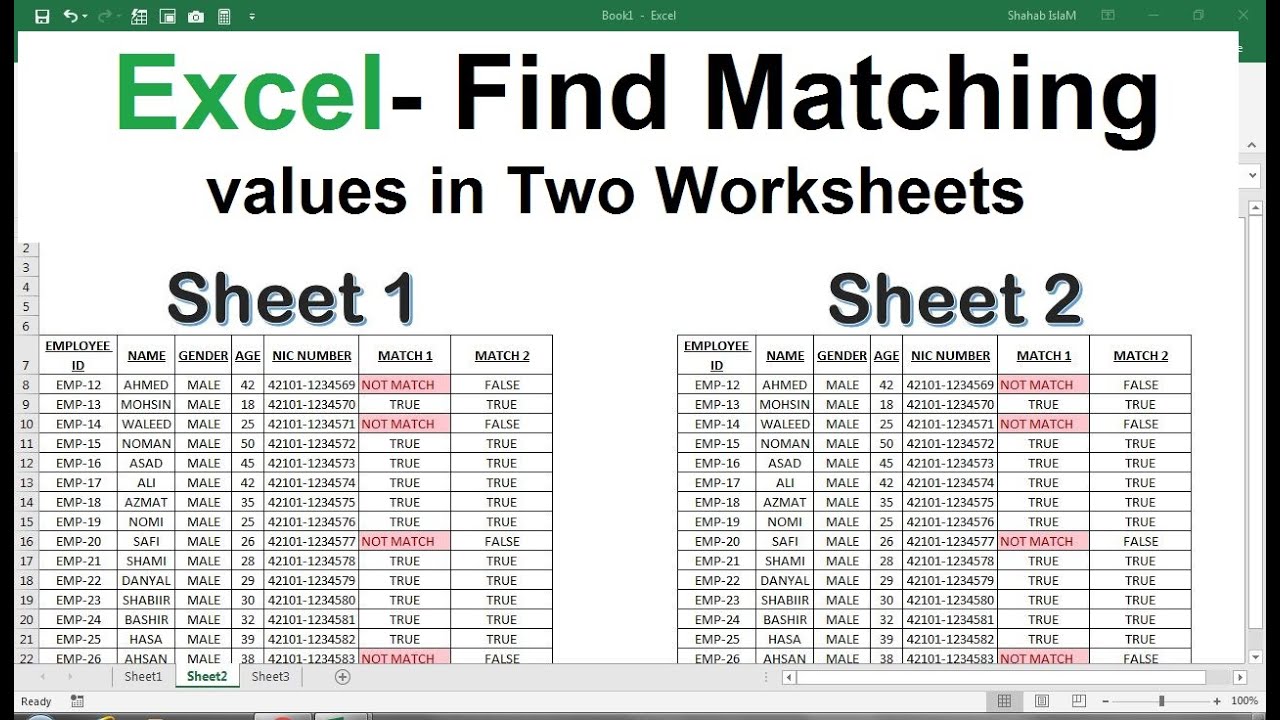5 Ways to Compare Excel Sheets for Matches

Comparing Excel sheets for matches is a task that many professionals and hobbyists alike might find themselves needing to do. Whether it's for reconciling financial data, merging customer databases, or tracking changes over time, the ability to efficiently compare two or more Excel sheets can save time and reduce errors. Here are five effective methods to compare Excel sheets:
1. Using VLOOKUP Function

VLOOKUP or Vertical Lookup is one of Excel's most popular lookup functions. It allows you to search for a value in the first column of a table and return a value in the same row from another column.
- Open both sheets in Excel.
- In the cell where you want to show the results, type
=VLOOKUP(...). - First parameter is the lookup value (from your first sheet).
- The second parameter is the entire range of the sheet you are looking up in.
- The third parameter is the column index number where the match is located.
- Set the last parameter to FALSE for an exact match.
🔍 Note: VLOOKUP will only work when the lookup column is the first column in the range you specify.
2. Conditional Formatting

Another way to compare Excel sheets visually is by using Conditional Formatting. This method highlights the differences between two sheets:
- Select the range in the first sheet.
- Go to Home > Conditional Formatting > New Rule.
- Choose "Use a formula to determine which cells to format."
- Enter a formula like
=NOT(ISERROR(VLOOKUP(A2,Sheet2!A:A,1,FALSE)))to check if the value in Sheet2 matches. - Select a format to highlight the cells where the formula returns FALSE.

3. Excel Compare Tool

For a more automated and detailed comparison, Excel has an in-built tool called Compare:
- Open both files.
- Go to the Review tab.
- Select the "Compare Sheets" option.
- Choose the files or sheets to compare.
- The tool will display the differences in a new window.
| Feature | VLOOKUP | Conditional Formatting | Excel Compare Tool |
|---|---|---|---|
| Complexity | Low to Medium | Medium | High |
| Visual Aid | No | Yes | Yes |
| Automated | Manual | Manual | Yes |

4. Using Power Query

Excel's Power Query is a powerful tool for data transformation and comparison:
- Select your data or table.
- Go to the Data tab > From Table/Range.
- Use "Merge Queries" from the Home tab to combine your sheets.
- Select a join kind that suits your needs (Inner, Left Outer, etc.).
- Check for matches or differences in the merged result.
💡 Note: Power Query can be complex for beginners but offers deep data manipulation capabilities.
5. Third-Party Tools

If Excel's native features are not enough, third-party tools can provide additional functionality:
- Spreadsheet Compare: Part of the Microsoft Office suite for Excel.
- Ablebits Compare Sheets: An add-on for Excel providing visual comparison tools.
- DiffEngineX: Another tool with features like version control integration.
In conclusion, comparing Excel sheets can be accomplished through various methods, each with its own strengths. Whether you're a beginner who prefers straightforward tools like VLOOKUP, or an advanced user looking for comprehensive analysis with Power Query or third-party tools, there's an approach to suit your needs. Remember, the choice of method should be influenced by the complexity of your data, your familiarity with Excel, and the desired output of the comparison.
What’s the easiest way to compare Excel sheets?

+
For beginners, VLOOKUP is often the easiest method due to its simplicity and effectiveness for direct data matching.
Can I compare Excel sheets without Excel installed?

+
Yes, you can use online tools like Google Sheets or third-party web-based services for comparing Excel files without installing Excel.
Are there any limitations when using VLOOKUP for comparing sheets?

+
Yes, VLOOKUP is limited to looking up in the leftmost column and returns only one matching value. It also might slow down your spreadsheet with large datasets.
How can I compare Excel sheets for differences rather than matches?

+
You can use conditional formatting to highlight differences or use tools like Excel’s Compare feature or third-party software for a more detailed comparison.
What’s the best method for comparing large datasets?

+
For large datasets, consider using Power Query or third-party tools for efficiency. These tools can handle large volumes of data more effectively than manual functions like VLOOKUP.



